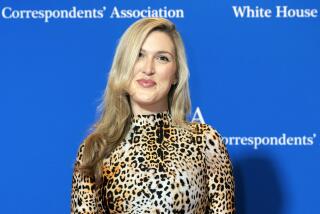John Hersey’s New Yorker Mea Culpa
- Share via
NEW YORK — The New Yorker magazine that arrived in readers’ mailboxes this week carried on Page 54 a Department of Amplification, the 76th in the periodical’s 63-year history.
In less genteel circles, an amplification might be known as a correction--or even a retraction.
It seems unthinkable, however, that a writer of the stature of John Hersey might be involved in anything so unseemly as a retraction.
But passages in Hersey’s essay on James Agee in the New Yorker’s July 18 edition bore certain similarities to prose from “James Agee: A Life,” a biography written by Laurence Bergreen and published by E. P. Dutton in 1984.
In fact, Bergreen said that when he read the Hersey Critic at Large essay, “the resemblance did seem to me to be overwhelming.”
Referring to the event as “copyright infringement,” Bergreen said: “I thought it was a very serious issue, because it encompassed my entire biography. There were numerous passages (in the Hersey essay) that were very closely modeled on my own. I’ve found 20 fairly lengthy ones so far.”
In his clarification, written in the form of a letter to the editors of the New Yorker, Hersey stated that he “did not give sufficient credit to some of the writings that had been helpful, beyond my own recollections, in the preparation of the article--works that recount various incidents from Agee’s life.”
He then acknowledged nine sources, and “especially, Laurence Bergreen’s ‘James Agee: A Life,’ the most comprehensive and thoroughly researched biography of Agee to appear in print so far. . . .”
Hersey concluded, “I very much regret any discourtesy on my part, or any distress caused to Mr. Bergreen or others by these omissions.”
Only an ‘Explanation’
At his home on Martha’s Vineyard, Hersey said the letter spoke for itself and said he considered the matter closed. Rhonda Pinzer, a New Yorker spokesperson, called Hersey’s letter “very gentlemanly.” She described an amplification as “further explanation, not necessarily an acknowledgment or apology.”
Pinzer bristled when asked if the situation had tested the New Yorker’s fabled system of fact checking, the supposedly ultra-methodical monitoring of details that was featured in “Bright Lights, Big City,” a novel by former New Yorker fact checker Jay McInerney.
“Fact checking at the New Yorker is designed to check out the accuracy of what is in a piece,” Pinzer said. “This piece is totally accurate. The question remains that Mr. Bergreen feels he had not been credited. That says nothing about the accuracy.
“I would say the magazine printed what it considered a very fine piece.”
Bergreen responded, “Well, if they had fact checked the piece, they would have seen very quickly where many of the phrases were coming from.”
Hersey’s essay on Agee was scheduled to appear in a new edition of Agee’s “Let Us Now Praise Famous Men.” A statement issued by the book’s publisher, Houghton Mifflin, said Hersey’s introduction will include crediting “of the sources on which he draws for facts about Mr. Agee’s life,” as well as bibliographical notes on the sources consulted.
Meanwhile, under the heading of what might be called the Department of Electronic Amplification, hints of the incursion of the late 20th Century on the musty halls of West 43rd Street continued with the appearance on our desk of a videotape from the New Yorker.
Given the magazine’s tradition of resolute silence on the subject of itself, this is roughly akin to receiving a cheery video on the inner workings of the Vatican, or maybe Mikhail Gorbachev’s golf secrets.
“Four From the New Yorker” was commissioned as a promotional film and was produced and directed by Academy Award-winning documentary maker Aviva Slesin.
Music, Familiar Names
It features a background of baroque flute music and brief interviews with cartoonist Ed Koren, revealing the story behind his “Cover Story”; journalist David Rieff explaining how he reported on Miami, “The Second Havana”; film critic Pauline Kael, seldom seen outside her own cinema community; and, in a major reversal of the policy of anonymity for writers of the Talk of the Town feature, Adam Gopnick wittily describing the similarities between his marriage and that of the Prince and Princess of Wales.
Shown to an enthusiastic audience of 500 at a private screening in New York not long ago, the film will “go on the road” in September, a spokesman for the magazine said. It will travel across the nation to illustrate what a fun group of people the New Yorker folks really are.
The very existence of “Four From the New Yorker” heralds a new kind of openness for the bastion of literary propriety known as the New Yorker.
Privacy Was Sacred
Under the 35-year editorial stewardship of William Shawn, the weekly jealously guarded its privacy. Shawn gave no interviews, and a visitor who once penetrated the sanctum of the magazine’s editorial department during Shawn’s regime was instructed by nervous New Yorker types to do her best to look like an advertising salesperson. (With its wooden desks and dusty bookshelves, the editorial work space resembled nothing so much as the English department of a fund-strapped land-grant university.)
The change is traceable to the acquisition of the New Yorker in 1985 by S. I. Newhouse Jr. In 1987, Newhouse replaced the 79-year-old Shawn with Robert Gottlieb, former publisher at Newhouse-owned Alfred A. Knopf Inc.
“We have had a much more active marketing effort since the acquisition,” the spokesman said.
Is nothing sacred? With supermarket-style cover flaps boldly proclaiming the contents of the magazine, and now, with a videotape, what’s next? Television ads in the fashion of People or the National Enquirer? T-shirts, umbrellas and handy canvas tote bags? MTV?
Who knows?
More to Read
Sign up for our Book Club newsletter
Get the latest news, events and more from the Los Angeles Times Book Club, and help us get L.A. reading and talking.
You may occasionally receive promotional content from the Los Angeles Times.










